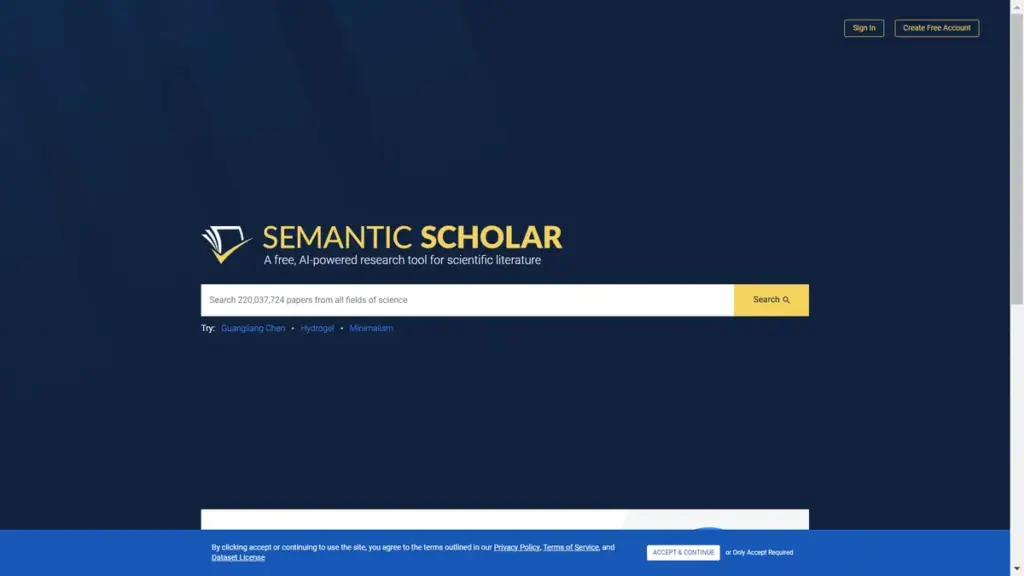
Understanding Semantic Scholar: Your Free AI-Driven Research Assistant
Semantic Scholar is a complimentary research tool leveraging artificial intelligence to facilitate the exploration of scientific literature. Developed at the Allen Institute for AI, this platform enables users to access a vast repository of over 219 million papers across diverse scientific disciplines. The primary aim is to aid researchers in efficiently finding and comprehending relevant studies, simplifying the research process.
With Semantic Scholar, you can connect with the most pertinent literature and assimilate insights swiftly, making it an essential resource for academics and practitioners alike.
How to Effectively Utilize Semantic Scholar
- Create a Free Account: Sign up to customize your experience and access additional features such as alerts and saved papers.
- Search for Literature: Use the search bar to look for papers, authors, or topics of interest. Filters are available to refine your results.
- Use Semantic Reader: Enhance your reading experience with the Semantic Reader, providing contextual understanding and augmented features.
- Set Up Alerts: Create alerts on your account to stay updated on new papers and citations relevant to your research.
- Explore Programmatic Access: Developers can take advantage of the API for deeper integration into applications, allowing compound searches and access to datasets.
Core Features of Semantic Scholar
- AI-Powered Search: Discover and interpret research efficiently.
- Semantic Reader: Offers enhanced reading capabilities by providing definitions and context for terms used in academic papers.
- Beta Features: Access early-stage features to provide feedback and shape future enhancements.
- Email Alerts: Stay current with new academic papers and citations.
- API Access: Programmatic data access for researchers and developers.
- Citation Insights: Comprehensive tools for tracking and analyzing citations and their significance.
Real-World Applications of Semantic Scholar
Semantic Scholar serves numerous purposes across various fields:
- Academic Research: Streamline the research process by quickly locating relevant literature.
- Thesis Development: Aid students in drafting thesis statements by providing easy access to supporting studies.
- Literature Reviews: Indispensable for compiling comprehensive literature reviews by easily retrieving related works.
- Collaboration: Facilitates collaborative projects by allowing researchers to share papers and insights seamlessly.
- Workshop Preparation: Utilize for preparing presentations or workshops with a wealth of academic resources.
Pricing Structure for Semantic Scholar
Semantic Scholar is completely free to use. There are no hidden costs or subscription fees, making it an accessible tool for researchers at all levels.
Frequently Asked Questions about Semantic Scholar
What sets Semantic Scholar apart from other academic search engines?
Semantic Scholar employs AI techniques to extract meaningful insights, helping researchers identify connections and enhance comprehension efficiently.
Is there an API available for Semantic Scholar?
Yes, the Semantic Scholar Academic Graph (S2AG) RESTful API offers programmatic access to data, facilitating high-impact research and engineering.
How can I access the full text of a paper?
Access options are provided below paper abstracts. If the paper is available, users will be redirected to obtain it. Some may be behind paywalls.
AI Keywords Related to Semantic Scholar
Additional Insights into Semantic Scholar
Semantic Scholar constantly updates its database, ensuring a growing corpus of articles for users. Current indexing is primarily focused on English-language papers, with hopes to expand support for other languages in the future.
Users can contribute by submitting papers for indexing and claiming author pages to manage their academic profiles. The platform continuously works on improving features, including the enhancement of beta tools and user experience.